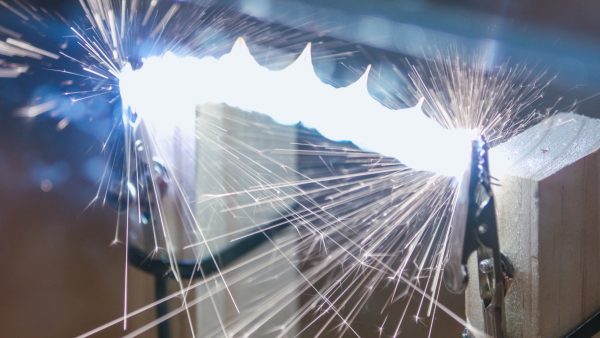Volts Definition
Volts measure potential energy in a circuit or battery. For example, you could use a higher volt battery for a brighter light bulb.
View Lesson on Electricity & Circuits
Become a member to get full access to our entire library of learning videos, reading material, quiz games, simple DIY activities & more.
Become a member to get full access to our entire library of learning videos, quiz games, & more.
Plans & Pricingto watch this full video.

Access All Videos
and Lessons, No Limits.
Access All Videos

No credit card required,
takes 7 sec to signup.
No card required

Ready-to-go lessons
that save you time.
Ready-to-go lessons
If you are on a school computer or network, ask your tech person to whitelist these URLs:
*.wistia.com, fast.wistia.com, fast.wistia.net, embedwistia-a.akamaihd.net
Sometimes a simple refresh solves this issue. If you need further help, contact us.
Electricity & Circuits
Fun Facts
- The difference between a 1.5-volt battery and a 9-volt battery is how many stacks of chemicals they have inside.
- Higher volts in a battery can make a motor spin faster.
- A 1.5 volt battery provides less energy than a nine volt battery.
Why Do We Need To Know About Volts
Learning about volts helps you understand how energy is stored and why it’s important for devices to work. Volts tell us how much energy is stored, which is key for the batteries in gadgets we use daily.
This isn’t just something you learn in school; it’s used in real life. Electrical engineers use volts to make things like robots, phones, and medical devices better, which helps improve technology and our lives.
Frequently Asked Questions
Check out the Full Lesson on Electricity & Circuits
In this lesson, we learn that:
- Electricity is the flow of electrical energy from one place to another.
- Electricity flows through conductors, but it cannot flow through insulators.
- A closed circuit is needed for electricity to flow and power our electronics.
Related Topics
- Absorbency Definition
- Algae Definition
- Batteries Definition
- Biochemistry Definition
- Carnivore Definition
- Chemical Reaction Definition
- Circuit Definition
- Computer Programming Definition
- Conductor Definition
- DNA Definition
- Decomposer Definition
- Definition Of Engineering
- Earthquake Definition
- Electric Charge Definition
- Electricity Definition
- Evaporation Definition
- Friction Definition
- Generator Definition
- Glacier Definition
- Insulator Definition
- Kuiper Belt Definition
- Latitude Definition
- Magnetic Field Definition
- Nervous System Definition
- Newton’s 3rd Law Of Motion Definition
- Non-renewable Energy Definition
- Opaque Definition
- Paleontologist Definition
- Pattern Definition
- Physical Change Definition
- Plant Growth Definition
- Pollinator Definition
- Rain Definition
- Renewable Resource Definition
- Respiratory System Definition
- Scientist Definition
- Season Definition
- Sediment Filter Definition
- Seed Definition
- Species Definition
- Star Definition
- Sun Definition
- Surface Runoff Definition
- Texture Definition
- Trait Definition
- Tsunami Definition
- Volcano Definition
- Volts Definition
Start a Free Trial Today. Get a $5 Amazon Gift Card!
Teachers! Start a free trial & we'll send your gift card within 1 day. Only cards left. Try it now.
Select Grade
Select Subject
This email is associated with a Science Kit subscription. Kit subscriptions are managed on this separate page: Manage Subscription

-
Download InvoiceScience & Math$/yr
-
Download InvoiceScience Only$/yr

access all lessons
• No credit card required •
"My students loved the videos. I started the video subscription in May and used them as a review before the state test, which I know contributed to 100% of my class passing the state test."
Rhonda Fox 4th Grade Teacher, Ocala, Florida
Use Generation Genius in Your School
Access all lessons free for 30 days.
"My students loved the videos. I started the video subscription in May and used them as a review before the state test, which I know contributed to 100% of my class passing the state test."
Rhonda Fox 4th Grade Teacher, Ocala, Florida
• No credit card required •
Already a member? Sign In
* no credit card required *

* no credit card required *
* no credit card required *


to Discover the Benefits of Generation Genius
Learn How to Save for Your School & District!

no credit card required
Skip, I will use a 3 day free trial
Enjoy your free 30 days trial
-
Unlimited access to our full library
of videos & lessons for grades K-5. -
You won’t be billed unless you keep your
account open past your 14-day free trial. -
You can cancel anytime in 1 click on the
manage account page or by emailing us.
-
Unlimited access to our full library of videos & lessons for grades K-5.
-
You won't be billed unless you keep your account open past 14 days.
-
You can cancel anytime in 1-click on the manage account page.
Cancel anytime in 1-click on the manage account page before the trial ends and you won't be charged.
Otherwise you will pay just $10 CAD/month for the service as long as your account is open.
Cancel anytime on the manage account page in 1-click and you won't be charged.
Otherwise you will pay $10 CAD/month for the service as long as your account is open.
We just sent you a confirmation email. Enjoy!
DoneWe use cookies to make your experience with this site better. By using this site you agree to our use of cookies. Click "Decline" to delete and block any non-essential cookies for this site on this specific property, device, and browser. Please read our privacy policy for more information on the cookies we use.Learn More
We use cookies to improve your experience. By using this site, you agree to our use of cookies. Click "Decline" to block non-essential cookies. See our privacy policy for details.Learn More




























































































































